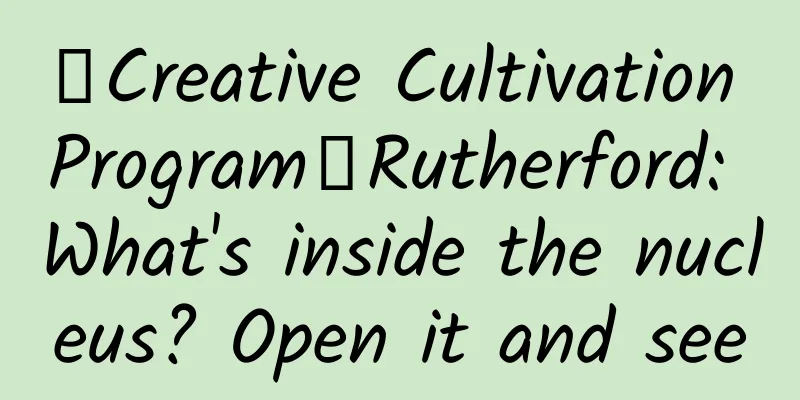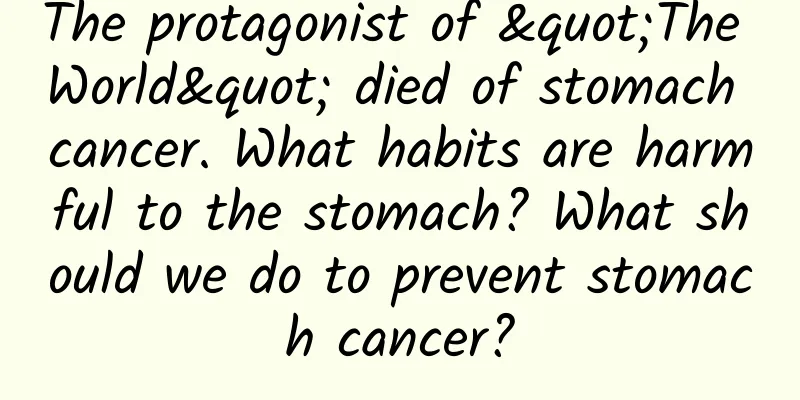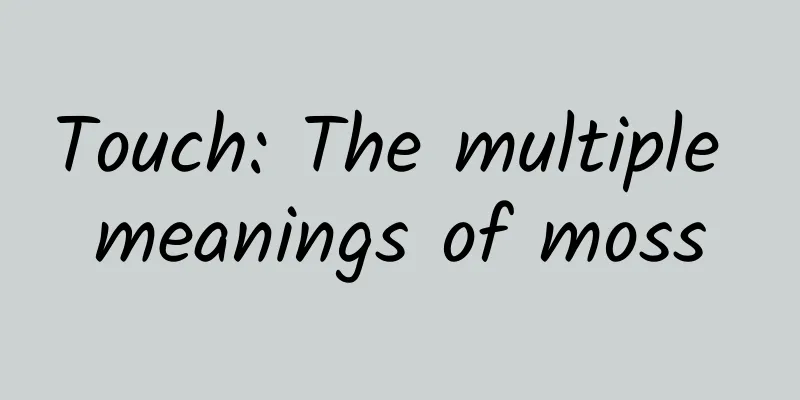【Creative Cultivation Program】Rutherford: What's inside the nucleus? Open it and see

|
Author: Tian Dawei Thanks to the joint efforts of Dalton, Brown, Einstein and Perrin, mankind has reached a consensus: atoms do exist. But Dalton's modern atomic theory mentioned that "atoms are indivisible". The nuclear energy that people use comes from the energy inside the nucleus. Next, it is imperative to open the nucleus and figure out the structure inside. So is the atom really the smallest unit that makes up matter? Can the atom be further split? It was three generations of teachers and students, Joseph Thomson, Ernest Rutherford, and James Chadwick, who solved this problem. Plum pudding model: peeling back the first veil of atoms The first scientist to discover the internal structure of the atom was Thomson. When Thomson was studying beta rays, he discovered that beta rays are composed of a type of negatively charged particle called an electron. Thomson believed that there should be such electrons in every atom. Moreover, Thomson proposed his raisin pudding atomic model: each atom is like a raisin pudding, with positive charges evenly distributed throughout the atom like pudding, and negatively charged electrons, like raisins, scattered on the pudding. Although this model is not highly praised in textbooks and is only mentioned briefly, it has its own important significance. It shows that atoms can be further split. The task of further splitting was given to his student, Rutherford. Rutherford's atomic model In 1901, when Rutherford was studying the radioactive element "thorium", he discovered that thorium could emit alpha rays. What was even more surprising was that after decay, thorium turned into another element. The idea that one element can be transformed into another only existed in the fantasy of alchemists in the past, but now Rutherford has actually confirmed it. This major discovery earned Rutherford the 1908 Nobel Prize in Chemistry. By the way, Rutherford was not happy after winning the Nobel Prize in Chemistry. He felt that he was a physicist and should have won the Nobel Prize in Physics. But the Nobel Prize was not important to Rutherford. Through his research on radioactive elements, he determined one thing: the energy released by radioactive elements comes from inside the atom. At that time, many people, including Marie Curie, believed that the energy of radioactive substances was absorbed from the outside. Therefore, Rutherford believed that Marie Curie did not know enough about radioactivity. If various kinds of rays can be emitted from inside an atom, this points to one thing: the atom can be further disassembled. So what is inside an atom? So Rutherford started bombarding atoms with alpha particles. This is the famous "gold foil experiment". In 1908, Rutherford, with the help of his assistant Geiger, continued to bombard the gold foil with alpha particles. They found that when the alpha particles passed through the gold foil, most of the particles passed straight through, while a small number of particles were deflected, which Rutherford called scattering, and a very small number of particles were greatly deflected. There must be a reason behind the abnormal phenomenon, so Rutherford focused his research on these particles with large deflections. He even asked his assistant to find out if there were any alpha particles that were bounced back. Although Rutherford himself did not hold out much hope, his assistant actually found that there were very, very few particles that were bounced straight back. In Rutherford's own words, it was like shooting a cannon at a piece of tissue paper, and the cannonball bounced back. These rebounded particles, like a cannonball, struck Rutherford's imagination. At that time, Rutherford already knew that alpha particles carry positive charges, and if such a large deflection occurred, one possibility was that they were affected by a very strong electromagnetic force. The particles that were bounced back should have hit the place where the charge was concentrated, which is the nucleus. According to calculations, the atomic nucleus should be very, very small, like a tennis ball placed in the Bird's Nest Stadium. But according to his teacher Thomson's raisin pudding model, the positive charge in the atom should be evenly distributed, and there shouldn't be such a concentrated positive charge in one place. Could it be that what the teacher said before was wrong? Rutherford was an extremely rigorous person, and he was not in a hurry to make his discovery public. He spent nearly four years confirming a large amount of data, and after confirming that it was foolproof, in 1911, the Rutherford model was first published. Rutherford believed that atoms were not indestructible. In the middle of an atom was a tiny positively charged nucleus, and outside it were electrons rotating around it at high speed. Right now, Rutherford had more important things to do. He needed to figure out what was inside the atomic nucleus. Rutherford continued to bombard other atoms with his beloved alpha particles. When bombarding nitrogen atoms, Rutherford discovered a phenomenon that when alpha particles collided with nitrogen atoms, hydrogen nuclei appeared, which later became protons. The fact that a hydrogen nucleus can be knocked out indicates that the hydrogen nucleus may be a component of the nitrogen nucleus. Moreover, the mass of the hydrogen nucleus is very light, and the masses of other nuclei are integer multiples of it. Is it possible that the hydrogen nucleus is a component of all nuclei? If so, this would be another significant discovery. In 1920, Rutherford announced his discovery that the hydrogen nucleus is the basic unit of all atomic nuclei. He gave this basic unit a name, the proton[1]. But Rutherford remained cautious. After announcing the discovery, he did not immediately announce the conclusion. Instead, he found another physicist, Patrick Blackett, to do more research to verify his hypothesis. After observing more than 400,000 tracks on 23,000 photos, they found 8 special tracks. Once again, from the anomaly, Rutherford made a major discovery. These 8 tracks can show that hydrogen nuclei are indeed components of the nuclei of other elements (these 8 tracks indicate that extremely unstable fluorine atoms were formed after the collision of nitrogen nuclei and alpha particles, and then decayed into an oxygen nucleus and a hydrogen nucleus). Then, in 1920, Rutherford announced his discovery that the hydrogen nucleus was the basic unit of all atomic nuclei. He gave this basic unit a name, the proton[1]. Thus, the most important particle in the atomic nucleus was discovered. The Curies pass by neutrons After Rutherford discovered the proton, he and his assistant Chadwick discovered another magical phenomenon. The weight of the nitrogen nucleus is about 14 times that of the hydrogen nucleus (about the same as 14 protons), but there are only 7 electrons. If there are only protons in the nucleus, then the nitrogen atom should be charged, which is unlikely. Therefore, Rutherford speculated that there should be another kind of neutral particle in the nucleus that is not charged, and its weight is about the same as that of protons. This neutral particle is the neutron. But so far, this is just a speculation, and Rutherford has no direct evidence to prove the existence of neutrons. The first people to discover this evidence were two German scientists, Walther Bothe and Herbert Becker. In 1930, they used alpha particles to bombard lithium, beryllium, boron and other elements. After the bombardment, they discovered a strange type of ray. This ray had high energy and was not charged. They believed that it should be gamma ray (a type of electromagnetic wave radiation) [2]. Some sources say that the first people to discover evidence of neutrons were Marie Curie’s daughter and son-in-law, namely, Marie Curie Jr., but this was not the case. However, Marie Curie Jr. did quickly start studying this type of radiation. They used this radiation to bombard other substances and obtained very high-energy protons [3]. Unfortunately, they did not doubt whether the radiation itself was gamma ray, so they did miss out on neutrons and a Nobel Prize medal. Rutherford's assistant Chadwick was keenly aware that this ray was not a gamma ray at all, but the neutron predicted by Rutherford. So Chadwick quickly repeated the experiment and proved that the ray was composed of a small particle with no charge and a mass very close to that of a proton, confirming the existence of the neutron. For this discovery, Chadwick won the 1935 Nobel Prize in Physics. By the way, another scientist named Lawrence also found that the explanations of Walther Bothe and the Curies were problematic and also devoted himself to research, but he was still one step behind Chadwick. However, Lawrence later made a very significant contribution to the development of nuclear energy by mankind because of another study and also won his own Nobel Prize. We will mention him again later. At this point, people not only discovered protons and neutrons within the atomic nucleus, but also knew that by changing the composition of the atomic nucleus, one substance can be transformed into another. Next, people will begin to reach into the nucleus and pick the energy fruits inside the nucleus. References: [1] Romer A (1997). "Proton or proton? Rutherford and the depths of the atom". American Journal of Physics. 65 (8): 707. [2] Bothe, W.; Becker, H. (1930). "Künstliche Erregung von Kern-γ-Strahlen" [Artificial excitation of nuclear γ-radiation]. Zeitschrift für Physik. 66 (5–6): 289–306. [3] Joliot-Curie, Irène & Joliot, Frédéric (1932). "Emission of high-speed protons by hydrogenated substances under the influence of very penetrating γ-rays". Comptes Rendus. 194: 273. |
<<: In fact, everyone is "love-brained"?
>>: How much energy was there at the time of the Big Bang? An incredible truth is deduced
Recommend
Madam, can you do some erotic art?
Have you seen these two emoticons recently? Color...
Electric Technology Car News: Are cheap MPVs bad products? The Lifan Xuanlang, which starts at RMB 70,000, makes it harder for joint venture cars to sell.
Today's domestic MPV market can be said to ha...
A diver was bitten by a moray eel underwater and his blood turned green...
Tim Powell is a diving enthusiast. In 2010, he up...
How to get new users? The method of attracting new customers is for old customers to bring in new ones!
How to acquire new users is the core topic in the...
In November 2023, the sales of China's new power car companies were obviously differentiated, and only Ideal made a profit of 2.8 billion in Q3
The sudden crash of Jiyue Automobile left a mess ...
Trump says he will withdraw from TPP as soon as he takes office. How will this affect the automobile industry?
On November 21, US time, Trump explained his 100-d...
How to increase user growth? Take Pinduoduo and Xiaohongshu as examples
Yesterday, I had the opportunity to listen to mor...
[Creative Cultivation Program] Snails run slowly, but they are not slow at all in “damaging” crops!
Author: Chatting and opening your mind Review: Hu...
What coincidental facts can prove that the existence of the solar system was carefully designed?
There has always been a saying that the existence...
How to quickly pass the self-media platform review? How to apply for a self-media platform to pass faster?
The hottest and most popular thing now is self-me...
"Nayuki's Tea" store operation and management notes!
On June 30, Nayuki’s Tea (02150.HK) was officiall...
The value of WeChat phone book is not overestimated
After the launch of WeChat Phone Book, my first i...
The master cracked the Trojan APP and burst into laughter at the end
Everyone knows that you should not click on the l...
The traffic ranking of information flow platforms in August, the first place is actually...
Are there always a few days every month when traf...
Alibaba invests $50 million in remote control app, playing a big game
In addition to focusing on the e-commerce field, ...









